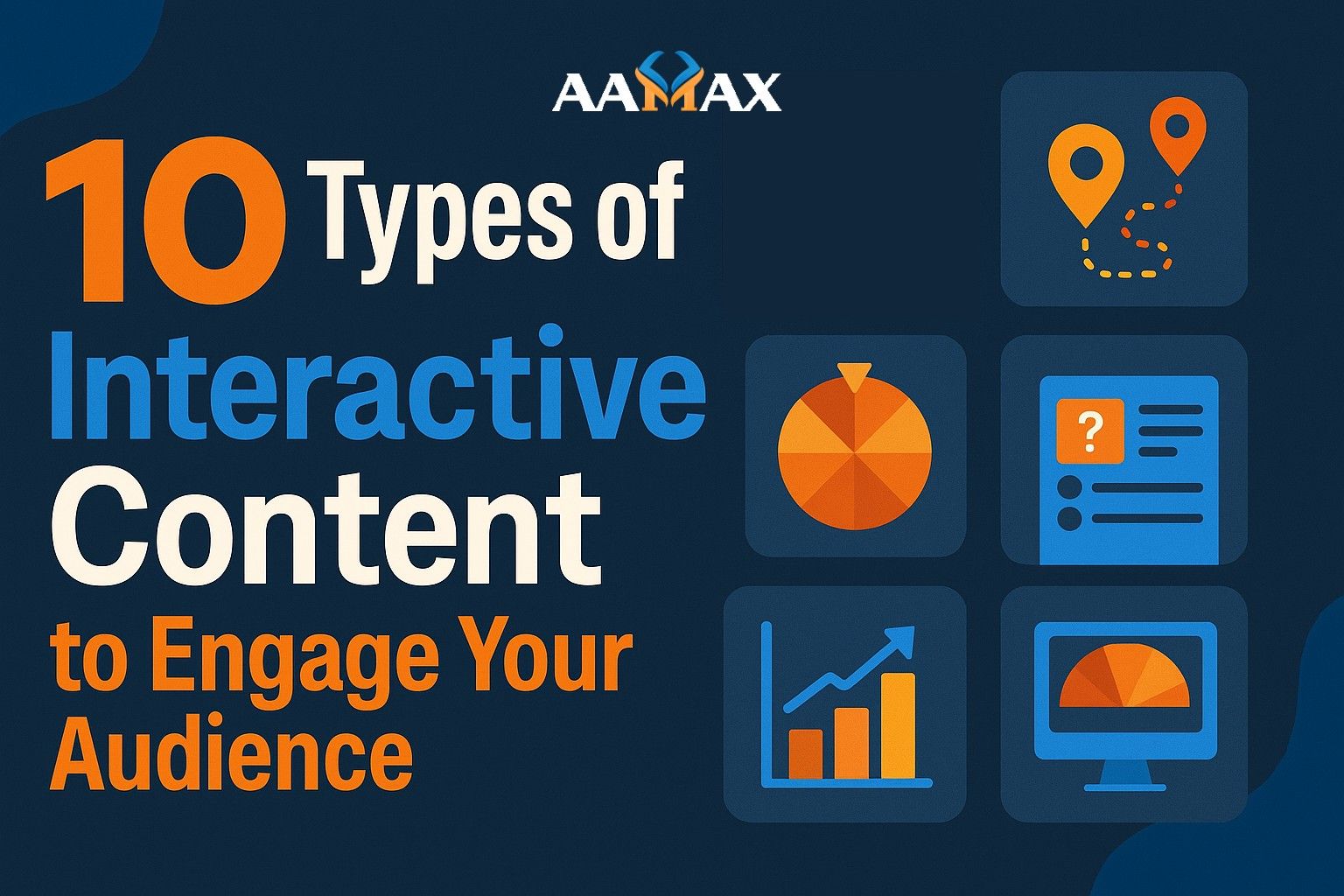
10 Types of Interactive Content to Engage Your Audience
In today’s competitive digital space, businesses face a major challenge: capturing and keeping their audience’s attention. Traditional static content like blog posts, infographics, and images are still valuable, but they no longer guarantee engagement in a crowded online world. Audiences now want immersive, interactive experiences that make them feel involved rather than passive readers.
Interactive content is one of the most effective tools for driving engagement, boosting lead generation, and increasing conversions. From quizzes to polls to interactive videos, interactive formats spark curiosity and motivate users to take action. In this article, we’ll explore 10 types of interactive content you can use to engage your audience, with practical insights into why they work and how to apply them effectively.
If you’re ready to transform your marketing strategy and need expert help, you can always AAMAX for professional digital marketing services. AAMAX is a full-service digital marketing agency offering Web Development, Digital Marketing, and SEO Services.
1. Quizzes and Personality Tests
Quizzes are a fun, highly shareable type of interactive content. People love discovering more about themselves or testing their knowledge, which is why quizzes consistently generate high engagement.
Why they work:
- They tap into curiosity and self-reflection.
- They encourage sharing—many users post their results on social media.
- They can help you capture leads by gating results behind an email opt-in.
Examples for businesses:
- A cleaning service could create a quiz titled “What’s Your Cleaning Personality?”
- A painter could ask “Which Color Palette Best Matches Your Home Style?”
When crafted well, quizzes can be both entertaining and informative, aligning with your brand’s goals while offering value to your audience.
2. Polls and Surveys
Polls and surveys are quick, interactive tools that invite audiences to share their opinions. They’re especially powerful on social media platforms like Instagram Stories, LinkedIn, or Twitter.
Why they work:
- They create instant interaction with minimal effort from the audience.
- They give you valuable market research insights.
- People enjoy seeing how their vote compares with others.
Example: A painting company might run a poll asking “Do you prefer matte or glossy finishes?” Not only does this engage users, but it also helps you understand customer preferences.
3. Interactive Infographics
Infographics are popular because they simplify complex data into visuals. Taking it a step further, interactive infographics allow users to click, hover, or scroll through information, making the experience more dynamic.
Why they work:
- They increase content dwell time.
- They simplify learning through interactivity.
- They stand out from static images and boost shareability.
Example: A digital marketing agency could create an interactive infographic showing how SEO rankings improve with specific strategies over time, allowing users to toggle between data sets.
4. Interactive Videos
Video content already dominates digital marketing, but interactive videos make the experience even richer. Instead of passively watching, users can click on choices, answer questions, or explore different paths in the video.
Why they work:
- They drive higher engagement compared to traditional videos.
- They create personalized experiences.
- They’re memorable, leaving a stronger impact.
Example: A home improvement brand could produce a video where viewers choose different wall colors in real-time to see how it changes the look of a room.
5. Calculators and Cost Estimators
People often want tailored answers—especially when it comes to costs or benefits. Online calculators and estimators are highly effective tools for lead generation.
Why they work:
- They provide personalized, practical insights.
- They encourage longer site visits.
- They can capture leads by offering detailed results via email.
Examples:
- A painter could create a calculator: “How Much Will It Cost to Paint My House?”
- A fitness business might offer a calorie calculator or BMI estimator.
These tools combine interactivity with value, making them highly effective at attracting and retaining customers.
6. Assessments and Graders
Assessments are slightly more detailed than quizzes, focusing on evaluating performance or knowledge in a specific area. Graders take this further by giving a score or evaluation.
Why they work:
- They give actionable results to users.
- They establish your authority in the niche.
- They’re excellent for B2B and professional services.
Example: A digital marketing company could create an SEO company grader tool that analyzes a website and gives an instant performance report.
7. Interactive Ebooks and Whitepapers
Ebooks are an excellent way to provide in-depth value, but they’re often long and static. Adding interactive features like clickable menus, embedded videos, or quizzes makes them more engaging.
Why they work:
- They provide a more enjoyable learning experience.
- They encourage deeper content consumption.
- They improve lead generation by making downloads more appealing.
Example: Instead of a plain PDF, a painting company could create an interactive ebook titled “The Ultimate Guide to Choosing the Right Paint for Your Home” with clickable color palettes and finish comparisons.
8. Contests and Giveaways
Everyone loves the chance to win something, and contests are a proven method to boost engagement. By making the contest interactive—such as submitting user-generated content or answering questions—you can increase participation.
Why they work:
- They drive social sharing and viral reach.
- They encourage user-generated content (UGC).
- They build excitement and community around your brand.
Example: A local business might run a photo contest: “Share your freshly painted room for a chance to win a free accent wall paint job!”
9. Interactive Timelines
Timelines help visualize history or processes in a clear, engaging way. Adding interactivity allows users to explore specific milestones or events at their own pace.
Why they work:
- They simplify complex stories.
- They allow for step-by-step exploration.
- They increase time spent on your content.
Example: A business could design an interactive timeline showing its journey, key projects, or customer success stories. This builds credibility and emotional connection with the audience.
10. Chatbots and Conversational Content
Chatbots are one of the fastest-growing interactive tools, often used for customer service, but they can also be leveraged for engagement and lead generation.
Why they work:
- They provide personalized, real-time interaction.
- They guide users through decisions (e.g., selecting a product or service).
- They help businesses capture leads seamlessly.
Example: A painting company’s website could have a chatbot that asks visitors about their home project, provides paint recommendations, and offers to book an appointment.
How to Make Interactive Content Work for You
Simply adding interactive elements isn’t enough; you need to align them with your business goals. Here’s how to ensure success:
- Know your audience – Understand their preferences and what types of content they enjoy.
- Keep it simple – Avoid overloading users with too many interactive features.
- Provide value – Make sure the content is not just fun, but also useful.
- Promote widely – Share your interactive content across social media, email campaigns, and websites.
- Measure performance – Track engagement, conversions, and ROI to see which formats work best.
Final Thoughts
Interactive content is no longer just a trend—it’s becoming a necessity for businesses that want to stand out online. From quizzes to calculators to chatbots, these tools keep your audience engaged, encourage them to spend more time with your brand, and often lead directly to conversions.
By experimenting with these 10 types of interactive content, you can create experiences that capture attention, delight your audience, and differentiate your brand from competitors.
And if you’re ready to take your strategy to the next level, consider working with professionals who specialize in crafting impactful content and campaigns. For expert support in Web Development, Digital Marketing, and SEO Services, you can AAMAX to help you build and execute a winning strategy.







